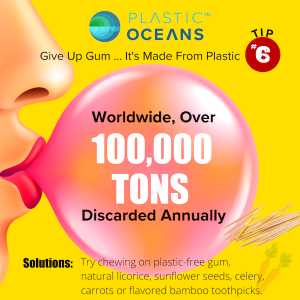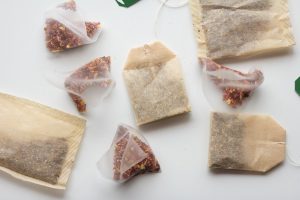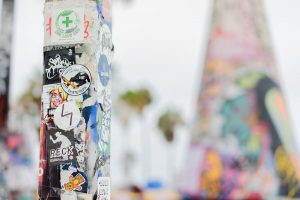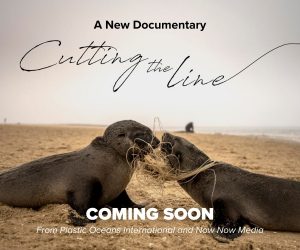An Often Unnoticed Material
Plastic is a ubiquitous part of our everyday lives. As we work to reduce our single-use consumption and increase our recycling, there are numerous products that contain plastic without us realizing it. Hidden plastics, if you will. Once you know which ones those are, it becomes easier to avoid them and find an alternative for them.
That’s why I have compiled a list of my top 10 products with hidden plastics:
 1) Tea Bags
1) Tea Bags
Almost all tea bags are lined with plastic (polypropylene) to help keep its shape when placed in boiling water. Because the bags are heated so much, they release microplastics into your tea. Those brands that claim to be plastic-free, use PLA (polylactic acid, also known as bioplastic) and are compostable when done in the right way. However, these usually still come wrapped in plastic.
Solutions: The best solution is to use loose tea leaves and a tea infuser. Paper bags are also better, but they are often sealed with plastic. Some of the brands that claim to be plastic-free are: Able & Cole, Clipper, and Teapigs.
2) Chewing Gum
Chewing gum used to be made from natural ingredients, such as tree sap, but commercial, modern-day chewing gum contains polyvinyl acetate, an ingredient used in the production of glue and latex paints. Polyvinyl acetate has been determined to be a possible carcinogen by the International Agency for Research on Cancer (IARC). You won’t find this ingredient on the label though, as chewing gum manufacturers are not required to disclose the full list of ingredients. Gum base, the main “ingredient”, is considered a trade secret. It’s also where the plastic is hiding.

CLICK HERE to view full infographic.
Solutions: There are some, not many, brands that make plastic-free chewing gum. Brands to consider are: Simply Gum, Chicza Gum, and Glee Gum. Alternatively, try chewing on natural options like liquorice root, sunflower seeds, or parsley if you want to get fresh breath.
3) Paper Cups and Cartons
Although they are made out of paper, disposable coffee cups and other paper food and drinks containers are lined with plastic. This makes it extremely difficult to recycle them. Besides, just like a tea bag, these cups leach microplastics into your drink.
Solutions: Invest in reusable cups and containers and take them with you for your beverage on the go or take-out food. With the pandemic still going and many venues refusing to allow reusable items, this is a tricky one at the moment, but use those reusables as soon as you can again! Brands to consider are: Bambuu, EcoVessel, Ecolunchboxes, Flaske and Klean Kanteen.
4) Clothing
All synthetic fibers, such as nylon, polyester and acrylic are made from plastic. Every time you wash your clothes, they shed microplastics, with fleece being the worst offender. Microfibers account for a big part of the microplastics found in our waters.
Solutions: Try to opt for clothing made from natural fibers, such as cotton, bamboo and hemp. Wash the synthetic items that you already have in a Guppyfriend bag or use a filter on your washing machine, to catch all those microplastics. Needless to say, don´t rinse those in the sink afterwards! Coraball and Planet Care are also great options.
5) Disposable Wipes
Whether we are talking about baby wipes, personal hygiene wipes, cleaning wipes or makeup removal wipes, these are all normally made with plastic. When they are tossed out in the bin, they end up in landfills. But lots of times they are being flushed down the toilet where they clog sewers and create fatbergs. Fatbergs are big chunks of solid waste consisting of wipes, personal hygiene products and solidified fat and are a huge problem for cities all around the world.
Solutions: Instead of wipes, choose reusable washable cloths and makeup pads.
6) Glitter
Glitter can be found in many products: they are used in arts and crafts, in cosmetics, on Christmas cards and on clothing. Glitter is made out of sheets of plastic – etched aluminum with polyethylene terephthalate (PET) to be precise. Glitters are small pieces of under 5 mm, classifying them as microplastics. When they get washed down the drain, or are blown away by the wind, they end up in our environment.
Solutions: There are brands that produce biodegradable glitter, but even then it might take a couple of weeks for the glitter to degrade. Besides, it is impossible to tell whether the glitter you are using is 100% biodegradable.
7) Cigarette Butts
Many people believe that cigarette butts are solely made out of cotton, but they actually contain non-biodegradable cellulose acetate. Some say they are the king of hidden plastics. Cigarette filters also contain toxic chemicals and with an estimated 4.5 trillion butts thrown away irresponsibly, it is the most littered item in the world.
Solution: Don’t smoke! If you must, please dispose of your cigarette butts responsibly.
 8) Stickers
8) Stickers
Stickers are made of some type of plastic, usually vinyl or polyester. As any other kind of plastic, as they start to decompose, they break down into microplastics.
Solutions: Luckily, there are initiatives to get rid of produce stickers by lasering the info on the fruit. As for other stickers, plastic-free alternatives exist, although they are not commonly used. Try to avoid using stickers whenever you can and refuse free stickers when they are being offered to you.
9) Menstrual Products
Mainstream menstrual products are not only packaged in plastics, but they also contain them. These hidden plastics can be harmful to the woman using the products, considering the way they are used. Furthermore, all these disposable products create a huge pile of non-recyclable waste.
Solutions: Consider using reusable pads, period-proof underwear or a menstrual cup. These are not only eco-friendly, but also friendly to your wallet! Natracare is one of many great brands that you’ll find featured in a recent blog post dedicated to this subject, including a nifty infographic, which you can find HERE.
10) Foil Packaging
Foil bags, such as chips bags, are not made of metal foil, but of metallized plastic film. This makes them unsuitable for recycling and so they normally end up in landfills.
Solutions: Scientists are working on more sustainable alternatives. Until they will be available, the best alternative is to make your own chips.
There is no conclusive evidence (yet) of the effects the ingestion of plastic has on humans, but we certainly know that we are consuming it (up to 40 pounds in a lifetime) and that plastics contain toxins. Be sure to check out our Humans Eating Plastic infographic.
With ever more ways for them to enter our bodies, I think everyone would prefer to be on the safe side in trying to minimize the amount of plastics we consume or expose ourselves to. Knowing where hidden plastics are found is a great first step!
Arlette Diederiks is the operations manager for Plastic Oceans Europe. She’s based in Portugal, where she puts her love of the ocean into action, using her experience at a diver and a finance professional to good use. She operates two other organizations: My Green Goodie Bag and The Blue Surfer.



